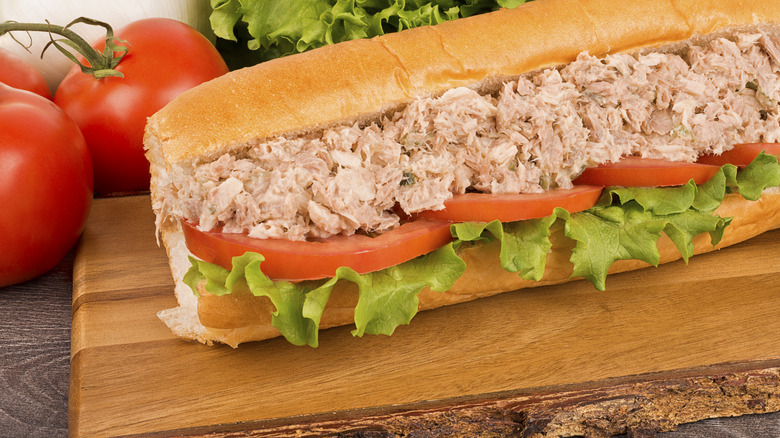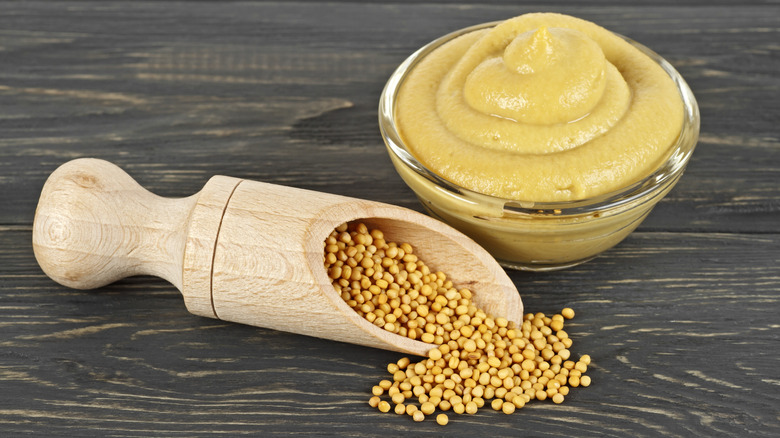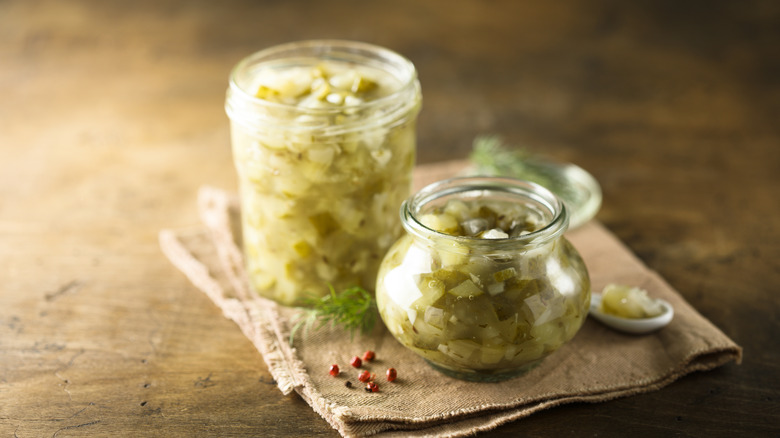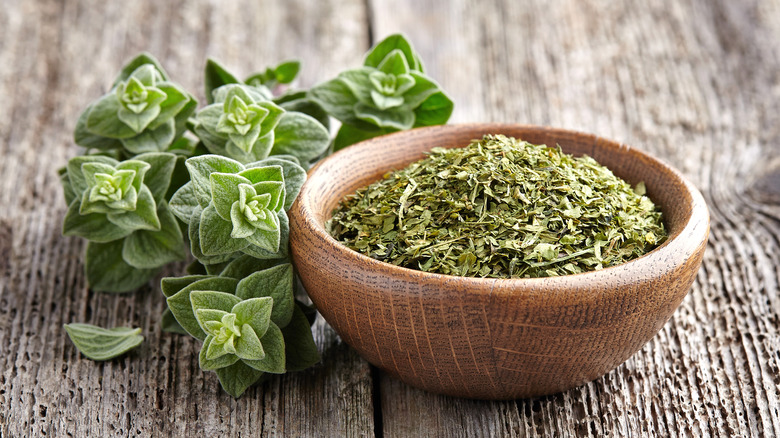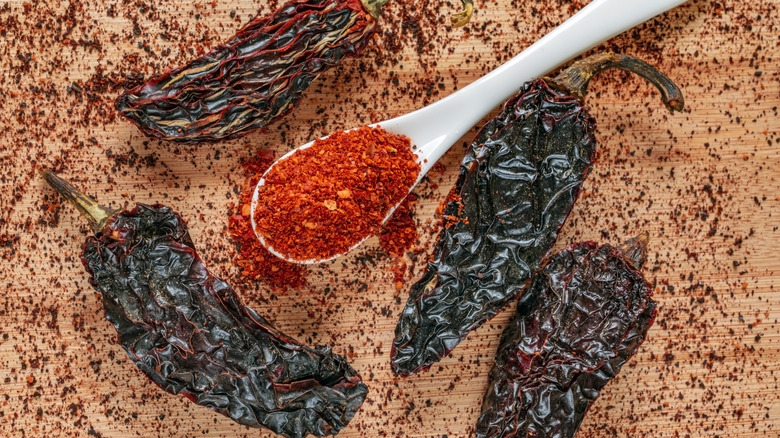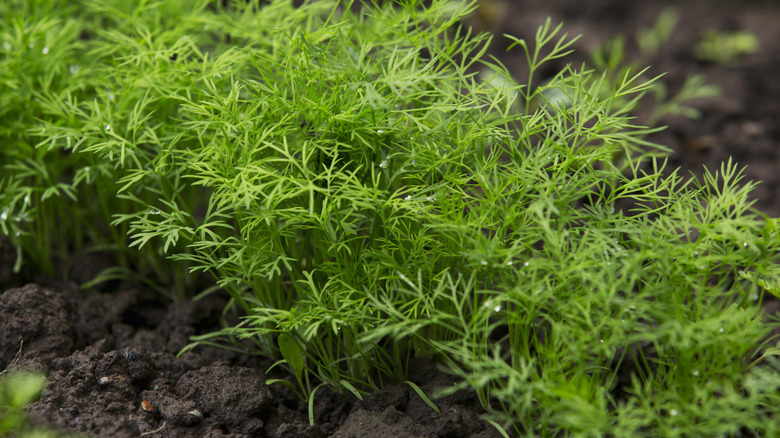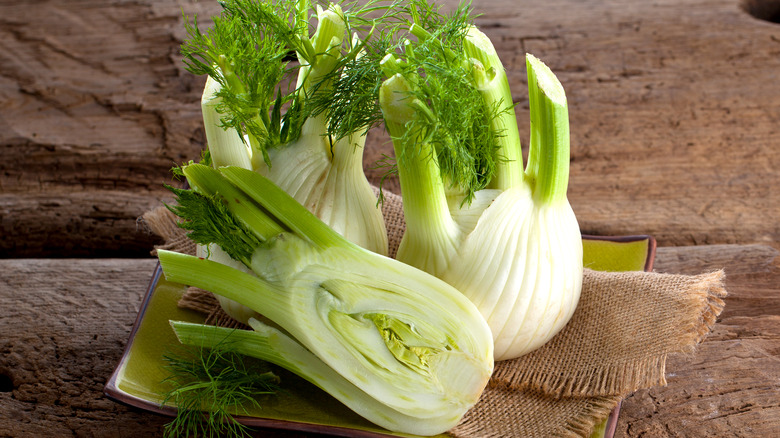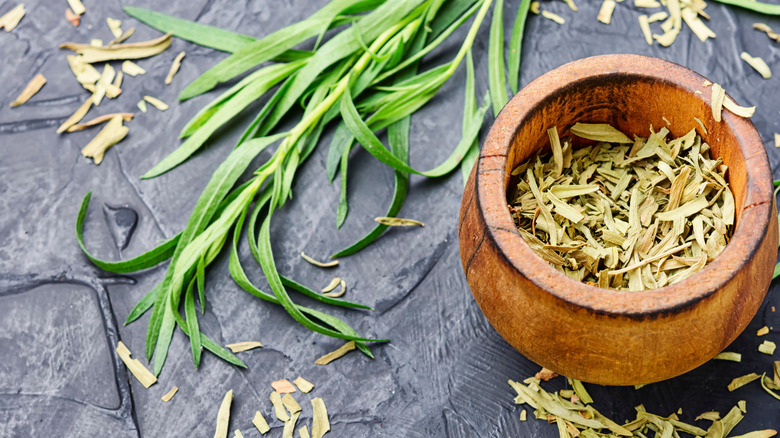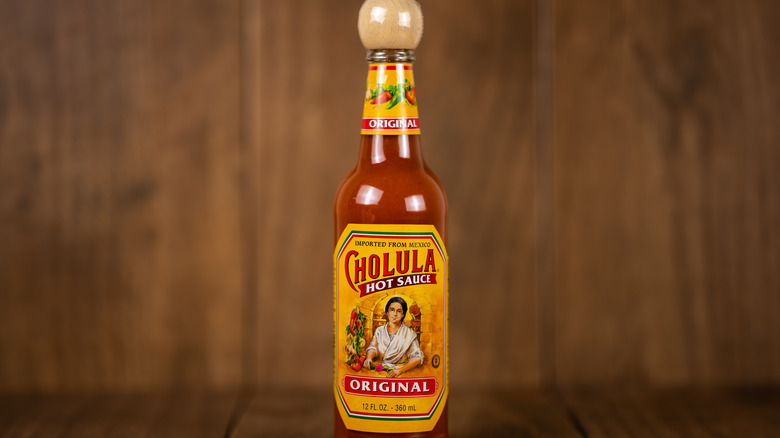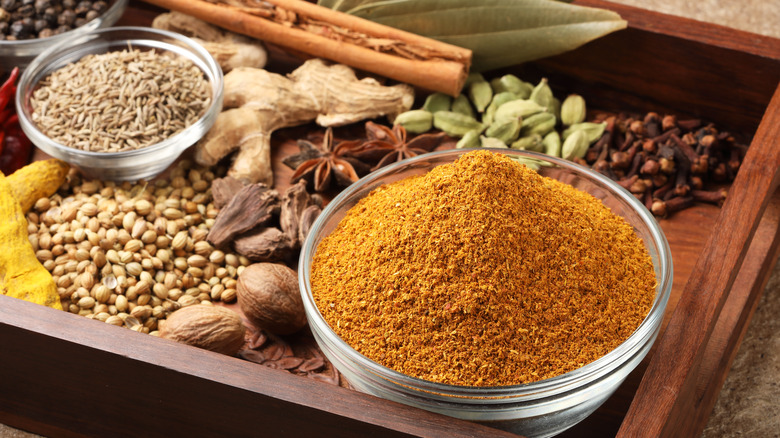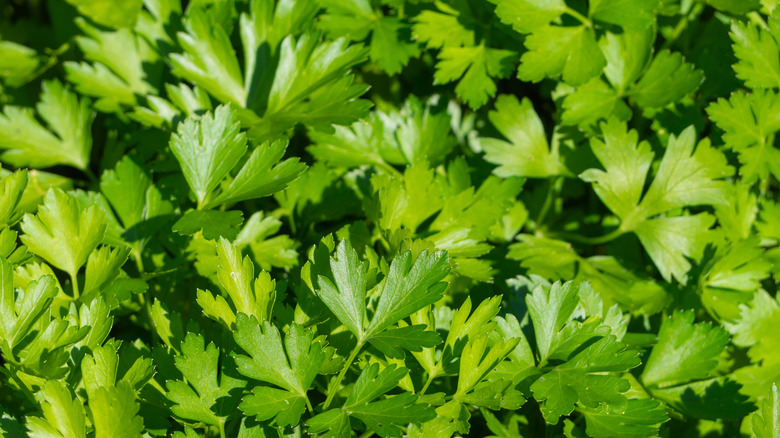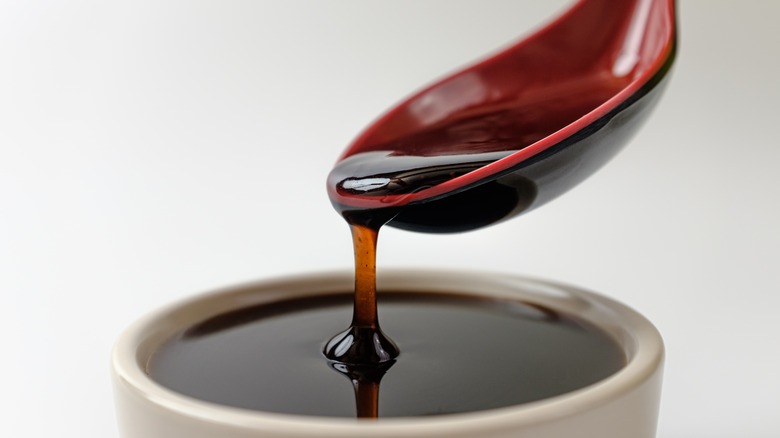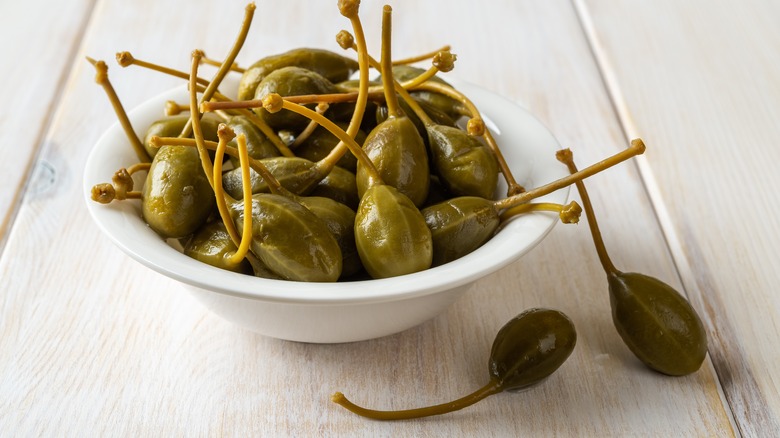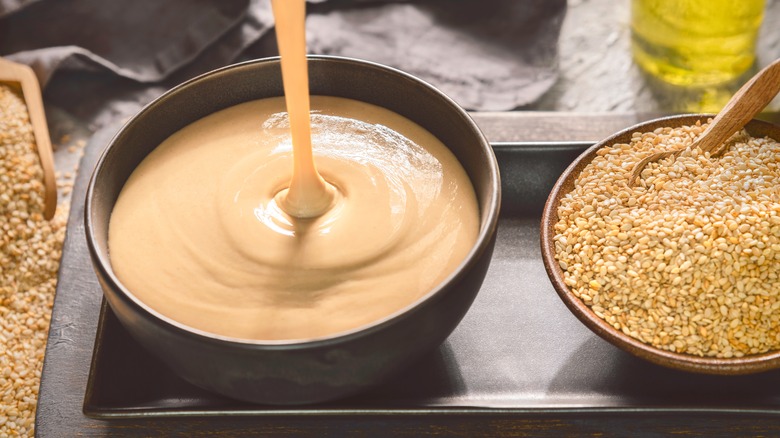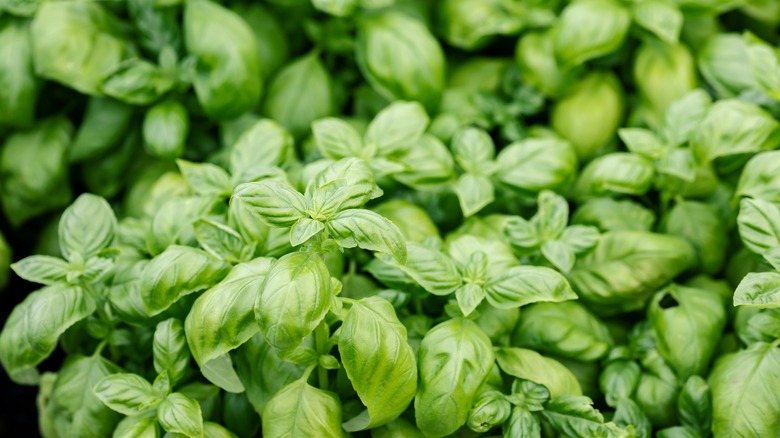14 Seasonings You Should Be Using In Tuna Salad
Tuna salad is about as reliable as they come. For generations, this lunchtime treat has been spread into sandwiches, onto crackers, and piled onto baked potatoes, and every time we think we're over it as a meal, it reminds us just how good it is. We mean, what's not to love? In its basic form, all it takes is a tin of tuna (usually albacore, skipjack, or yellowfin tuna), some mayo, and a few choice additions, and you're left with a meal that's packed with protein, omega-3 fatty acids, and a whole lotta taste.
But as with all simple things, if you're gonna do tuna salad, you have to do it right. While the standard recipe of tuna and mayo is hard to mess up, there's no denying that without quality ingredients, things aren't gonna be super tasty. And in addition to having good-quality fish and mayonnaise, you also need good, well-suited seasonings, both to make your meal taste even better and to keep it interesting. Not all seasonings go with this dish, but the ones that do take it from good to awesome — and we've got our favorites right here.
1. Dijon mustard
Few things go better with tuna salad than a little bit of Dijon mustard. Although it's a standard ingredient in a lot of tuna salad recipes, like this traditional tuna salad, it's all too easy to forget. Once you've had tuna salad without Dijon mustard, though, you'll realize how much you're missing: The condiment gives a tangy complexity that's hard to replicate with anything else and helps to both temper the saltiness of the dish and lift the overall taste.
It's useful to note that some mustards can be pretty hot, and adding too much can irritate your sinuses pretty significantly. This is due to a specific oil compound that's also present in horseradish and wasabi and provides a different type of heat than chilis. For this reason, it's advisable to err on the side of caution and add in a little mustard at first, do a taste test, and then put more in if needed. If you're catering for a group of six people, 1 tablespoon of Dijon mustard should be plenty to start with.
2. Sweet relish
With its briny, meaty taste, tuna is a savory food through and through, and we generally don't associate it with sweetness. However, a slightly sweet element, when picked judiciously, can be a great thing to include in your tuna salad recipe, and sweet relish is one of the best condiments out there to throw in.
Sweet relish provides a hit of sweetness, a touch of acidity from the vinegar used to pickle the vegetables included, a little salt, and some pleasing layers of flavor from the pickling spices. Put all this together, and there's a reason why this addition is beloved by none other than former president of the United States Barack Obama, in his recipe for tuna salad: It tastes really good. The taste of sweet relish can become overpowering if you're using too much of it, so we'd recommend starting with 1 tablespoon for a four-person portion. One of the best things about using sweet relish is that thanks to its combo of acid, sweet, and salty, you don't have to worry about including additional vinegar or sodium, so don't be tempted to amp up the dish even further by throwing these in alongside it.
3. Oregano
While herbs are a vital addition to an enormous number of meals, for whatever reason, we may not think of putting them in tuna salad sometimes. But we really should, y'all. And we're not necessarily talking about fresh herbs here (although those, too, are pretty delicious in a tuna baguette); we're talking about that good old-fashioned dried stuff.
Dried herbs like oregano can be a great choice in tuna salads, as the slightly milder, floral taste of dried oregano won't overwhelm the fish but rather supply it with a pleasant undertone. As one of the key flavors of Italian and Greek cuisine, dried oregano can also be combined with ingredients like olives, red onion, and other herbs to make a Mediterranean tuna salad. With dried oregano, despite it being less pungent than its fresh counterpart, it's still advisable to use slightly less than you might think, as even a touch too much can make your tuna salad a little too fragrant and throw off the balance of the rest of the ingredients. For eight people, 1 teaspoon of the herb should be more than enough and will help amp up the other Mediterranean flavors in the dish.
4. Chipotle
We're all about trying to freshen up old classics with new flavors, but we've gotta say, we never thought we'd be putting chipotle into our tuna salad. Well, folks, we're here to tell you, we've all been missing out. Chipotle peppers, which are dried, smoked jalapeños, have an inimitable blend of smokiness, heat, and tangy sweetness that instantly develops flavor in a dish. Chipotle peppers are the ideal choice for people who want a touch of spice without the fire that things like cayenne pepper or hot sauce might deliver, and in tuna salad, they give you layers of flavor that complement the briny fish.
In this smoked jalapeño tuna salad sandwich, the chipotle is supplied by first making a chipotle mayonnaise, combining mayo and chipotle pepper puree, and then mixing it in with the rest of the tuna salad ingredients. It then layers the chipotle-infused tuna under avocado, tomato, and arugula for a Mexican-inspired lunch. Chipotle purees can come in a range of different flavors, depending on the peppers used to make them, so you may find that using different purees results in significantly different results. But that's all part of the fun of it, and we can pretty much guarantee you'll never be disappointed.
5. Dill
Okay, so it's not said enough, but dill? It's pretty dill-ightful. Okay, we'll show ourselves out for that terrible joke.
Before we go, though, we just need to explain to you exactly why we love dill so much, and particularly why it's so good in tuna salad. Dill has a flavor that's somehow both bold and gentle, with aniseed undertones and a grassy edge. This particular combination pairs excellently with fish, and while you're more likely to see dill sprinkled on top of smoked salmon, it works very well when chopped up thoroughly and mixed into tuna salad, too.
However, we recognize that not everyone will have a bunch of fresh dill in their fridge, which is why if you're in a pinch, dill pickles can be a great substitute. Flavored with dill, these pickles also add a sourness to tuna salad, foregoing the need for vinegar or lemon juice. Chopped-up dill pickles also give your tuna salad a satisfying crunchy element and can also serve to bulk out the dish, providing even more lunch for your buck. Dill relish and dill pickle juice can also provide similar flavors, with dill relish also giving some sweetness.
6. Fennel
One of tuna salad's main draws lies in how accessible its taste is (hey, they don't call it "Chicken of the Sea" for nothing), but on occasion, it pays to throw caution to the wind and try out some new, bold flavors with it. So, if you're feeling adventurous, grab yourself some fennel. While fennel can look pretty similar to celery and dill, it has a flavor profile of its very own, with a deep, licorice-like taste that can be a little much for some. When mixed into tuna salad, however, those flavors play against the saltiness of the tuna and are mellowed by the mayonnaise — and the whole thing becomes pretty special.
You can use any part of the fennel plant, but for a more delicate flavor, opt for the leafier fronds. If you wish, you can also use the more fibrous bulb of the plant, but bear in mind that not only is this part of it stronger-tasting but will also make more of a textural impact in your tuna salad. If you do use the bulb, just ensure that you're chopping it up super fine, as the last thing you want is to be chewing on huge chunks of fennel.
7. Tarragon
There's something about tarragon that just screams class. But, if you're more accustomed to enjoying the taste of this herb in French bistros, we're here to tell you that it can be used in a variety of everyday recipes, too, like tuna salad. The gentle, citrus-like taste of tarragon pairs well with the saltiness of tuna, and when combined with lemon, as in this tuna salad with lemon tarragon dressing, it gives the meal a real brightness.
Tarragon can also be added to tuna salad in the form of tarragon vinegar, which will give a hint of the herb while also providing some acid. If you only have dried tarragon at hand, it's perfectly fine to toss it in, as the above recipe recommends — but just make sure you crush it up well first so that it amalgamates with the rest of the elements properly. Unlike some other herbs, dried tarragon tends to have a stronger taste than its fresh counterpart, so if you're using fresh, you might need more than you think to get the same result.
8. Hot sauce
Classic tuna salad isn't exactly known for being spicy, and sometimes, all you want is a comforting, mellow dish. But for those situations where you want to take the heat up a notch, a few dashes of hot sauce are just what you need.
Hot sauce works well with tuna to elevate its flavors, and the good news is that you can put in whatever hot sauce you have at hand. For folks who prefer a slightly sweeter, more garlicky heat, squirt in a few teaspoons of sriracha, which brings the heat in a spicy tuna and egg salad sandwich alongside two types of mustard and paprika. If you want things to be slightly more sour, shake in a few dashes of Cholula. Not only does this bring a bit of heat, but you'll be in the company of none other than Nick Jonas, who makes his tuna salad the same way.
When adding hot sauce, bear in mind that it's super easy to get carried away and make a tuna salad that's way too hot. To avoid this, begin with a small amount and do a taste test. Keep doing this until you reach the perfect level of heat.
9. Curry powder
Fish is a common addition to curries all around the world, and yet, when it comes to tuna salad, curry powder is usually not the first flavor we opt for. But to put a spin on an old classic, curry powder could be just the thing you need. Curried flavors from curry powder already have a proven track record in mayo-based dishes like coronation chicken, and adding it to tuna salad gives a similar complexity. And one of the best things about curry powder is it takes all of the hard work out of picking spices and packs flavors like cumin, coriander, fenugreek, black pepper, cardamom, turmeric, and chilies into one easy-to-add blend. No measuring endless spoonfuls of spices here, people!
As different curry powders have different blends of spices and heat levels, it could be worth buying a few different types and seeing which works best for you. One of the most well-known spice blends, garam masala, is a great choice for folks who want curry flavors without too much heat, as it tends to have a sweeter and richer taste. Garam masala spices are also toasted before blending, so the flavor can be more developed than other curry powders, which may use raw spices.
10. Parsley
A well-made tuna salad feels fresh while still using creamier, heavier elements like mayonnaise to bring it all together. But that freshness doesn't just come out of nowhere: It usually comes from the addition of lighter seasonings and condiments, to balance everything out.
And if it's freshness you're after, it's hard to go wrong with parsley. The classic herb, which adorns so many dishes as a garnish, is also a great way to bring a touch of vibrancy to tuna salad. For four servings of the dish using a 12-ounce can of tuna, throw in ¼ cup of parsley, making sure you chop it thoroughly to ensure you don't have any big chunks floating around in your meal. For a slightly more boisterous taste of the herb, don't be afraid to use the parsley stems, too, but be advised that you may want to slice them well, as they can be tougher than the leaves. Additional parsley can be used as a garnish.
11. Soy sauce
If you've ever eaten a tomato or a mushroom or experienced the intense hit of a mouthful of anchovy, you've tasted umami. The savory taste occurs naturally in a variety of foods and gives them a deep, meaty quality that makes them irresistible.
And if you're seeking to amp up umami for tuna salad, there's an easy addition you can make: a few dashes of soy sauce. Soy sauce goes surprisingly well in tuna salad and supports the slightly sharper tastes of fish and the density of the mayo with a savory undertone.
However, it's important to bear a few things in mind when adding soy sauce. The condiment comes in many different shapes and forms, from sweet soy sauce to rich, thick dark soy, and the more widely known light soy sauce. While you can use whichever sauce you wish, light soy generally works best in tuna salad, as it won't become the dominant flavor in the dish and instead just works to amp up the other elements. Crucially, too, soy sauce is high in sodium, and as you may be working with tuna that's been packed in brine, things can get pretty salty if you're not careful. Try to find a low-sodium soy sauce or a "no salt added" tuna, so that you can control the salt levels.
12. Capers
Capers and fish just work together, guys. These tiny, pickled bites, which begin life as the buds of the caper bush and end it on your plate, have a citrusy, briny, slightly funky taste that lifts the flavors of fish through the roof.
And in tuna salad, capers bring the dish to life, providing several of the elements needed to amp up the flavors of the meal, such as salt and acid. How you add the capers is largely up to you. If you're using slightly smaller nonpareil capers, as in this tuna melt panini recipe, you might find that it's not necessary to chop them up at all, and you can just throw them in whole, enjoying the little flavor bombs as you encounter them. For larger capers, biting into a whole one can be a little intrusive, so you might want to chop them up before adding them in. Despite their tiny size, capers bring a lot of flavor and are very salty, so if you're using them for the first time, don't be tempted to throw extra capers in. They come in those tiny jars for a reason: A little goes a long way.
13. Tahini
Wait, what? Bear with us; we'll explain. Tahini, made by grinding up sesame seeds with oil until they form a paste, is far more commonly seen in hummus or salad dressings than in tuna salad. But adding it to tuna salad brings a distinctive nutty flavor to your meal that takes it far beyond your regular sandwich.
Additionally, tahini provides a wealth of healthy fats, which complement the omega-3-rich tuna, bolster the protein content in the meal, and also supply you with some useful antioxidants. When using tahini, remember that, as a creamy liquid, it operates similarly to mayonnaise, so you may find that you want to use less mayo instead of adding them both in similar quantities. It's also useful to note that while some tahinis pour well straight out of the jar, in the majority of cases, it tends to separate when on the shelf, with the sesame paste sinking to the bottom and the oil rising to the top. In this case, all you need is to give it a good stir to incorporate the two elements before you put it in your tuna salad.
14. Basil
Herbs work superbly in tuna salad, but basil may not be your top choice to add to your sandwich. After all, the herb has a bold, fruity flavor that works fabulously with more neutral-tasting foods like pasta — but when it comes to tuna, can it hold its own?
As it turns out, yes. Basil is an awesome herb to throw into tuna salad and works so well that none other than Martha Stewart includes it in her recipe. In Stewart's salad, which also has chopped apples in the tuna blend, the basil adds a zestiness and freshness, while the apple provides some sugar and lifts the tuna. Chop up your basil finely, so that it spreads through the tuna salad well, and make sure you're using the freshest herbs possible. As it has pretty tender leaves, basil can bruise pretty easily, so to slice it, stack them on top of each other, roll them up, and then chop with a sharp knife. This method, approved by Gordon Ramsay, should give you perfectly shredded basil without any bruised edges.
